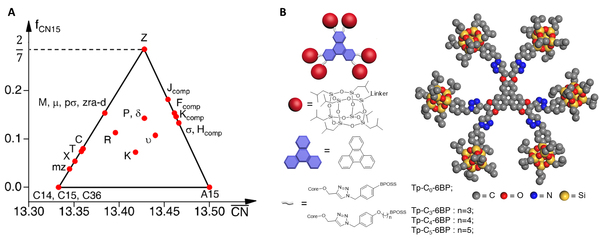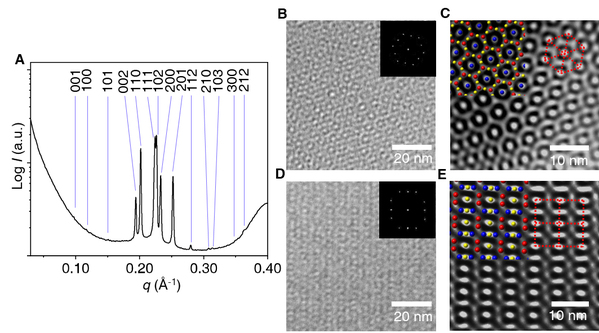Humans have continued to explore microscopic structures of matter. Three decades ago, the discovery of quasicrystal expanded the list of crystal classifications from 230 space group symmetry to infinity. Between the cases of ordered but nonperiodic quasicrystal, and simple densely packed structures, there is a class of metal alloy crystal structures, so-called Frank-Kasper (F-K) phases.
Often, F-K phases can be viewed as ordered approximates of quasicrystal phases due to some shared construction rules from sphere packing. So far, 27 different types of F-K phases have been found experimentally. Among them, A15, C15 and Z phases adopt three fundamental structures that provide the basic units to construct all the other F-K phases so far reported. In the bulk system of single- component self-assembly, Percec et al. reported the observation of A15 phase in 1997; Bates et al. reported the observation of C15 in 2017; the Z phase remains the only one of the three fundamental structures for the 27 discovered FK phases that has not been observed in any soft matter system. The formation of Z phase requires a relatively large volume asymmetry between its constituent polyhedral particle motifs and relatively large average coordination number (13.428). It is still a challenge to satisfy both requirements at the same time in soft matters.
Recently, Prof. Stephen Z. D. Cheng’s group collaborating with Prof. Mingjun Huang et al from South China Advanced Institute for Soft Matter Science and Technology rationally discovered the unique Z phase in the bulk state of soft matter for the first time. They designed a series of nanosized shape amphiphiles, in which a triphenylene core is attached to six identical polyhedral oligomeric silsesquioxane (POSS) cages at the periphery through covalent linkers with tunable lengths (Figure 1B). Compared with traditional polymer, the self-assembly of nanosized shape amphiphiles is a powerful platform to create diverse structures in soft matter because their composition, molecular topology and molecular weight can be precisely controlled. Owing to the tunable steric hindrance by the rigid and bulky POSS cages, these nanosized shape amphiphiles do not self-assemble into a one-dimensional columnar structure, as commonly observed in plate-like molecules. Moreover, the tunability of the linker length enables the formation of a series of ordered spherical phases, including a Z phase.

Figure 1. A, The relationship of observed F-K phases. B, The chemical structure of nanosized shape amphiphiles.
For the nanosized shape amphiphile, Tp-C0-6BP, forms an A15 phase, after annealing at 150 ℃; increasing the annealing temperature to 170 ℃, the sample forms a Z phase. Small angle X-ray scattering (SAXS) and transmission electron microscope (TEM) confirmed the formation of the Z phase in reciprocal space and real space, respectively (Figure 2). Moreover, the Z phase can form directly from the disordered melt without passing through the low-temperature A15 phase. The Z phase can also transform into an A15 phase after annealing at 150 ℃. These results indicate that the phase transition between the A15 phase and the Z phase is a typical enantiotropic phase behavior.

Figure 2. A, SAXS profile of Z phase. B, C, D and E, TEM image of Z phase from different directions.
The authors also investigate the mechanism of the phase transition between the A15 and Z phases. At molecular level, the spherical motifs in the A15 phase contains 4 molecules. However, relatively larger motifs in the Z phase contains 4 molecules, and relatively small motifs in the Z phase contains 3 molecules. Therefore, the volume ratio between the different motifs in the Z phase is ∼1.33, which reaches the volume asymmetry ratio range required by the Z phase.Increasing the temperature weakens the π–π interactions of the cores and strengthens the thermal fluctuation and/or expansion of the bulky BPOSS cages. This flexibility may facilitate the exchange of nanosized molecules between spherical motifs and enable the redistribution of the polyhedral motifs to form the Z phase. At the lattice level, the lattice of the Z phase is formed after a translation vector on the (001) direction of the A15 lattice. This mechanism was proved by TEM image. The self-assemblies of other nanosized shape amphiphiles and more details, please find them in the original paper.
on the (001) direction of the A15 lattice. This mechanism was proved by TEM image. The self-assemblies of other nanosized shape amphiphiles and more details, please find them in the original paper.

Figure 3. A and B, Schematic illustration of the phase transition between A15 phase and Z phase.
In conclusion, this article from Nature Chemistry reported the first observation of the Z phase in the bulk state, together with the A15 and C15 phases, represent the three fundamental structures that provide the building blocks to construct all 27 F-K phases discovered.The self-assembly of these nanosized shape amphiphiles results in a variety of highly ordered unconventional supramolecular lattices. This platform presents a feasible method to reach a relatively large volume asymmetry ratio between the assembled motifs. Therefore, ordered phases that include but are not limited to FK phases formed by relatively large volume asymmetry ratios of two or more types of spherical motifs may no longer be out of reach for single-component soft matter.
The authors of this article are Zebin Su, Chih-Hao Hsu, Zihao Gong, Xueyan Feng, Jiahao Huang, Ruimeng Zhang, Yu Wang, Jialin Mao, Chrys Wesdemiotis, Tao li, Soenke Seifert, Wei Zhang, Takuzo Aida, Mingjun Huang* and Stephen Z. D. Cheng*.
The link of this article is https://www.nature.com/articles/s41557-019-0330-x
